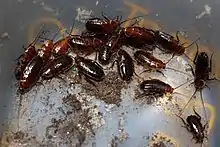| Parcoblatta divisa | |
|---|---|
 | |
| Parcoblatta divisa nymphs | |
| Scientific classification | |
| Domain: | Eukaryota |
| Kingdom: | Animalia |
| Phylum: | Arthropoda |
| Class: | Insecta |
| Order: | Blattodea |
| Family: | Ectobiidae |
| Genus: | Parcoblatta |
| Species: | P. divisa |
| Binomial name | |
| Parcoblatta divisa (Saussure & Zehntner, 1893) | |
| Synonyms | |
| |
Parcoblatta divisa, the southern wood cockroach, is a species of cockroach native to the United States.[2][3]
Due to morphological similarities, it was earlier considered a subspecies of Parcoblatta pensylvanica, termed P. pensylvanica divisa, found in the lower part of the southeastern United States.[4] In particular, males of the two species are different from others of their genus in that the seventh dorsal abdominal segment conceals almost all of the eighth segment (more pronounced in P. pensylvanica), and share a specialialized character of protuberances of the median segment.[5]
Individuals of the species are typically dark in color, but a pale morph is uniquely found in Alachua County, Florida, with no dark individuals among hundreds of specimens collected from the location.[6]
| Male[4] | Female[4] | |
|---|---|---|
| Body length | 13.8–17.6 mm (0.54–0.69 in) | 12.7–16.5 mm (0.50–0.65 in) |
| Pronotum length | 3.6–4.6 mm (0.14–0.18 in) | 3.7–4.9 mm (0.15–0.19 in) |
| Pronotum width | 4.8–6.2 mm (0.19–0.24 in) | 4.7–6.6 mm (0.19–0.26 in) |
| Tegmina length | 16.4–20.8 mm (0.65–0.82 in) | 7.2–10.8 mm (0.28–0.43 in) |
| Tegmina width | 5.1–6.6 mm (0.20–0.26 in) | 4.0–4.9 mm (0.16–0.19 in) |
Distribution
The distribution of the species includes the eastern and southeastern United States, including Alabama, Arkansas, Delaware, Florida, Georgia, Kansas, Louisiana, Maryland, Mississippi, New Jersey, North Carolina, Oklahoma, Pennsylvania, Tennessee, Texas, Virginia, and Wisconsin.[7]
Habitat
Parcoblatta divisa has been found in diverse habitats including dry pine lands, oak scrub, moist hammocks of northern Florida, and cool ravines along Florida's Apalachicola River.[8]
Many collected specimens have been taken from under signs attached to trees (red and white oaks, shortleaf and longleaf pines, American sweet gum, and other deciduous trees), and trapped in molasses-baited jars.[8] One researcher who collected specimens extensively found it to be the most adaptable of the Parcoblatta species, trapping adults among logs and undergrowth on the borders of woodland areas, and taking specimens from pasture grasses, in grass under backyard trees, under dried cow dung, under trash and debris at woodland campsights, and from homes in wooded areas, which the species is sometimes reported to invade.[9][10]
Additional images
 Adult male
Adult male Male P. divisa nymph from North Carolina.
Male P. divisa nymph from North Carolina.
References
- ↑ "Synonyms of southern wood cockroach (Parcoblatta divisa)". Encyclopedia of Life. Retrieved 2014-03-24.
- ↑ "ITIS Standard Report Page: Parcoblatta divisa". Integrated Taxonomic Information System. Retrieved 2014-03-20.
- ↑ Beccaloni, GW (2007). "species Parcoblatta divisa (Saussure & Zehntner, 1893)". Blattodea Species File Online. Retrieved 2014-03-20.
- 1 2 3 Blatchley, Willis Stanley (1920). Orthoptera of northeastern America: with especial reference to the faunas of Indiana and Florida. The Nature Publishing Company. pp. 88–89, 776.
- ↑ Hebard, Morgan (1917). "The Blattidae of North America north of the Mexican boundary". Memoirs of the American Entomological Society. American Entomological Society (2): 133–134. (The article comprises the whole issue.)
- ↑ Robinson, William H. (2005). Urban Insects and Arachnids: A Handbook of Urban Entomology. Cambridge University Press. p. 4. ISBN 978-0-521-81253-5.
- ↑ Atkinson, Thomas H.; Koehler, Philip G.; Patterson, Richard S. (1990). "Annotated checklist of cockroaches of Florida (Dictyoptera: Blattaria: Blattidae, Polyphagidae, Blattellidae, Blaberidae)" (PDF). Florida Entomologist. 73 (2): 316. doi:10.2307/3494816.
- 1 2 Roth, Louis M.; Willis, Edwin R. (1960). "Biotic associations of cockroaches". Smithsonian Miscellaneous Collections. Washington, D.C.: The Smithsonian Institution. 141: 59.
- ↑ Lawson, Fred A. (1967). "Ecological and collecting notes on eight species of Parcoblatta (Orthoptera: Blattidae) and certain other cockroaches". Journal of the Kansas Entomological Society. 40 (3): 267–269. JSTOR 25083633.
- ↑ Bell, WJ; Roth, LM; Nalepa, CA (2007). Cockroaches: Ecology, Behavior, and Natural History. JHU Press. p. 49. ISBN 978-0-8018-8616-4.
External links
- Drawings from a 1917 article by Morgan Hebard. Plate V, labeled 11-16, of P. divisa body parts and views of two female specimens, one with exceptionally developed wings. Key to drawings on pages 278-279.